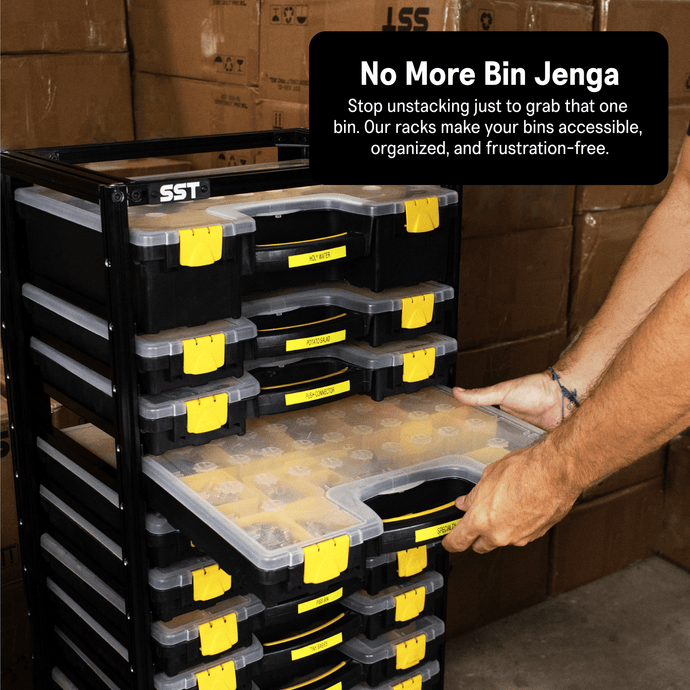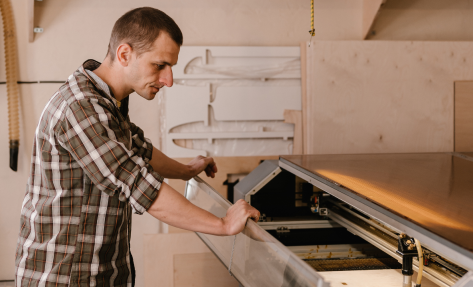SST Shop Talk
Top 5 Workshop Organization Hacks with Tool Organizers + Parts Bin Racks

Is your workshop starting to look like a chaotic junk drawer with walls? You’re not alone. Whether you're a weekend warrior or a full-time fabricator, workshop clutter kills productivity—and mood. But with a few smart upgrades, you can transform your space into a lean, mean making machine.
Here are the Top 5 Workshop Organization Hacks that’ll bring order to the chaos, featuring some of the smartest, simplest storage solutions out there—including our Parts Bin Organizer Rack, Power Tool Organizer, and Welding Bottle Organizer.
1. Group Your Mess of Harbor Freight Bins with our Parts Bin Organizer Rack
Why it works:
That stack of bins is one bad Jenga move from disaster. Our organizer rack not only keeps them organized, but also accessible without risk of a mess. Our caster wheels also allow you to wheel them wherever you need!
The fix:
Use our Parts Bin Organizer Rack for your bins. You'll be able to instantly see what’s where without playing the guessing game. Modular design means you can scale it up as your tool hoard grows.
2. Create a Power Tool Charging Station
Why it works:
Drills, drivers, batteries—and those chargers with 4-foot-long cords—love to form tangled nests on your workbench. You need quick access without the mess.
The fix:
The Power Tool Organizer keeps everything in one place, with dedicated slots for power tools and a top shelf to dock and charge batteries. It mounts on your wall, clearing precious work surface and turning a tool explosion into a sleek power station.
Pro tip: Label each charger with its battery voltage. Future-you will thank you.
3. Build Vertical Zones by Function
Why it works:
Most clutter isn’t from having too much stuff—it’s from stuff being in the wrong place. Grouping by task (e.g., welding, cutting, assembly) keeps you focused and fast.
The fix:
Create function-based vertical zones. For instance, place your Welding Bottle Organizer directly on your bottle. It holds your torches, clamps, gloves, helmets, etc. Everything is where you need it, not across the shop behind a pile of rags.
4. Label Everything Like a Maniac
Why it works:
When everything’s labeled, nothing gets lost. It also helps guests (or forgetful future-you) put things back in the right spot.
The fix:
Use a label maker or painter's tape + Sharpie for bins, drawers, and shelves. Even power tools. Combine this with a Parts Bin Organizer Rack, and you’ll never wonder where the 1/4” washers ran off to again.
5. Use “Dead Space” for Storage
Why it works:
Every shop has wasted vertical space—above workbenches, between studs, under shelves. That’s prime real estate.
The fix:
Mount your Power Tool Organizer or Welding Bottle Organizer in these dead zones to free up your bench and floor. Need even more room? Hang brackets from the ceiling for long stock, hoses, or ladders.
Final Thoughts: Keep It Stupid Simple
Organization doesn’t have to be fancy—just functional. These five hacks, powered by smart tool organizers like the Parts Bin Organizer Rack, Power Tool Organizer, and Welding Bottle Organizer, can transform your shop from frustrating to efficient.
The Programmer
The first person is the CNC programmer. He is like the "playmaker". He will create the programs that the CNC machines are intended to execute. Since the programs are in the form of CNC codes fabricated like sentences, he should have mastered these codes because they work like a different language. The regular CNC machine can use up to 50 codes, so that's like learning 50 new words for the newbie.
Also, the programmer should have at least and engineering or machining degree. Remember that the CNC machine will only execute WHAT IT IS PROGRAMMED TO DO. If the program is wrong, the whole operation goes down the drain with it. Moreover he should also be flexible and have a fast turn-around because a CNC machine is often used to machine a huge selection of different work-pieces.

The Technician
The third person that will need is the CNC technician. Although this may still be the programmer, it is more convenient to always have a technical expert on-call because in the long run, you may have more than one CNC machine and you may need to prioritize over the other in case both gets crippled at the same time. Just like the programmer, the technician should also be flexible and articulate. CNC offers a lot of complexity when it is running right, how much more if it is behaving badly?
So, if you are having job openings for positions that need to be handling a CNC machine, ask the applicants first to do a demo for you and make sure that during the demo, they know what they're doing. An exam may also do wonders too. If they have no experience with any kind of CNC machine, it is advisable that you encourage them to take short courses on CNC.
Eighty-hour courses are available online and hey, it is better than nothing. Experts even encourage employers to hire CNC machinists who have finished AND PASSED the National Occupational Competency Testing Institute (NOCTI) assessment just so they could be sure that their CNC machines will go to good hands. After all, a CNC machine is still an asset.

The Operator
The second person that you need is the CNC operator. He will simply recheck the programs loaded to the machine and push the right buttons to get the work done. However, thinking that a CNC operator can have little or NO SKILL AT ALL is wrong. A CNC machine operator must have at least basic machining skills and he should have undergone some form of training to run a CNC machine.
These machines can produce very intricate motions, making it possible to make shapes that cannot be created on conventional machine tools. So, the operator should foresee this complexity and know how to cruise with it. The skills that an operator must have though, are lesser compared to the operators of conventional machine tools.



